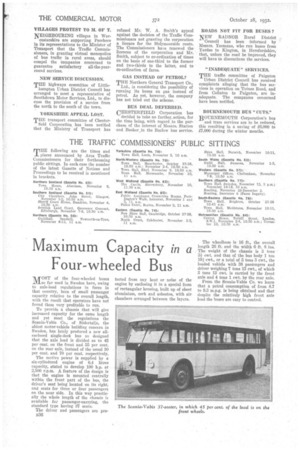Maximum Capacity in a
Page 62

If you've noticed an error in this article please click here to report it so we can fix it.
Four-wheeled Bus
MOST of the four-wheeled buses s() far used in Sweden have, owing to axle-load regulations in force in that country, been of small passenger capacity relative to the overall length, with the result that operators have not found them very profitable to run.
To provide a chassis that will give increased capacity for the same length and yet meet the regulations the Scania-Vabis Co., of Siidertalje, the oldest motor-vehicle building concern in Sweden, has lately produced a new allenclosed single-deck bus so designed that the axle load is divided as to 45 per cent. on the front and 55 per cent. on the rear axle, instead of the usual 30 per cent. and 70 per cent. respectively.
The motive power is supplied by a six-cylindered engine of 6.4 litres capacity, stated to develop 100 h.p. at 2,500 r.p.m. A feature of the design is that the engine is mounted centrally within the front part of the bus, the driver's seat being located on its right, and seats for three or four passengers on the near side. In this way practically the whole length of the chassis is available • Lye passenger-carrying, the standard type having 37 seats.
The driver and passengers are proB36
tected from any heat or noise of the engine by enclosing it in a special form of rectangular housing, built up of sheet aluminium, cork and asbestos, with air chambers arranged between the layers. The wheelbase is 16 ft., the overall length 26 ft. and the width 6 ft. S ins. The weight of the chassis is 3 tons 3,-k cwt. and that of the bus body 1 ton 19i cwt., or a total of 5 tons 3 cwt., the loaded vehicle with 38 passengers and driver weighing 7 tons 13 cwt., of which 3 tons 12 cwt. is carried by the front axle and 4 tons 1 cwt. by the rear axle.
From the Scania-Vabis Co. we learn that a petrol consumption of from 8.7 to 9.3 m.p.g. is being obtained and that despite the relatively high front axle load the buses are easy to control.






































































































